In a at last week’s American College of Sports Medicine conference, two teams of researchers presented new data on something called the “,” which has been used since the 1970s to estimate how much energy it takes to hump a pack. A British team how load distribution patterns affect the estimates, since modern soldiers carry weight in different places thanks to things like body armor, instead of having their full load crammed into a backpack. And a U.S. Army team differences between men and women, since women are now filling combat roles that require carrying heavy loads.
The results of these studies are mildly interesting. (In brief, modern soldiers burn more energy than the equation predicts, because it’s more efficient to carry loads on your back. And men burn more energy than women while carrying a given weight, but the equation isn’t quite right for either.)
But the real revelation to me was the original Pandolf question. Here’s a simple tool that tells you how many calories you’re ��burning as a function of your weight, your pack’s weight, your hiking speed, the incline of the slope you’re walking on, and the nature of the terrain. Amazing! Even if it has some mild inaccuracies in the absolute numbers it calculates, it offers an objective way of answering some of the logistical questions that you face when planning a backpacking trip. How much extra energy will it cost you to haul an optional luxury like your camp chair? How much will you slow down on a prolonged climb or in sandy terrain if you maintain a roughly constant effort level? What’s the most efficient speed if you’re carrying a particularly heavy pack? Or a particularly light one?
How the Backpacking Calculator Works
I spent some time playing around with the equation to see what it tells us, using the example of a 150-pound person carrying a 50-pound pack at 4 miles per hour on a gravel path as the reference case. The equation itself isn’t particularly revealing, but for the record here it is:
M = 1.5 W + 2.0 (W + L)(L/W)2 + n(W + L)(1.5V2 + 0.35VG)
Here M is the metabolic rate, which is how quickly you’re burning energy. This equation gives you a value in watts, but that’s easy to convert to other units like calories per hour.
The inputs into the equation are:
- W: your weight (kg)
- L: the weight of your pack (kg)
- V: your hiking speed (m/s)
- G: the grade of any incline (%)
- n: a “terrain factor” that adjusts the results for different surfaces (for example, a paved road has a terrain factor of 1.0, but a gravel road is 1.2, since it takes more calories to walk on a soft or uneven surface)
For the equation to work as written, you have to use the units I’ve listed above. For the remainder of this article and for the interactive calculator at the bottom of the page, I’ve converted to pounds for the weights and miles per hour for hiking speed.
So if you plug my reference case numbers into the equation, you find that this hypothetical hiker (let’s call him “Alex H”) is burning about 555 calories per hour. That means that over a six-hour hiking day, he’d be burning 3,330 calories. That’s a lot of GORP.
To be fair, not all of those calories are directly related to hiking. Notice that the equation has three terms in it. The first term reflects the energy cost of simply standing still, supporting your own weight. In this case, that’s 88 calories per hour. The second term reflects the energy of standing still with a pack on. The pack adds another 17 calories per hour. And the third term is where the action is, incorporating the energy needed to walk at a given speed, with the effect of gradient and terrain included—in this case, an extra 450 calories per hour.
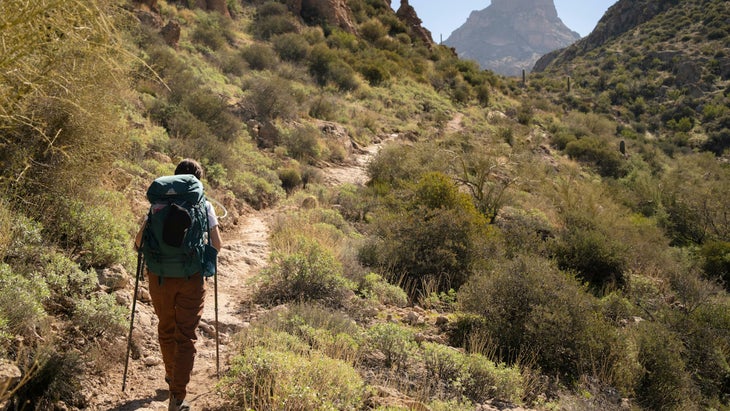
What Happens When the Conditions Change
That gives us a baseline estimate of the caloric demands of backpacking, so now we can explore what happens when the conditions change. For example, what is the effect of increasing your pack weight between 20 pounds and 100 pounds (shown along the horizontal axis)? And how does that change if you walk at different speeds from 1 mph to 5 mph (shown with different lines)?
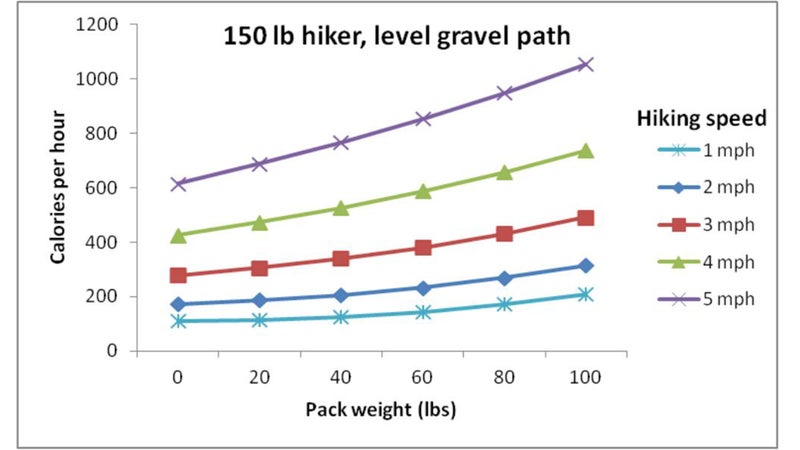
Admittedly, the conclusions here aren’t earth-shattering. The heavier your pack, the more energy you burn. At 4 mph, doubling your pack weight from 40 lbs to 80 lbs increases your calorie burn from 526 per hour to 657 per hour, an increase of about 25 percent. You pay a steeper penalty for adding 20 pounds to a heavy pack than to a light pack.
This could be useful to know for trip-planning, for example, to figure out how far you can reasonably expect to make it in a given amount of time. But if you’ve already decided how much distance you’re going to cover, then you have to consider that the faster you hike, the less time you’ll spend hiking. That means that hiking faster might sometimes actually be more efficient overall, since you’re burning more calories but for a shorter time. So let’s look again at the same data, but expressed as calories per mile instead of calories per hour:
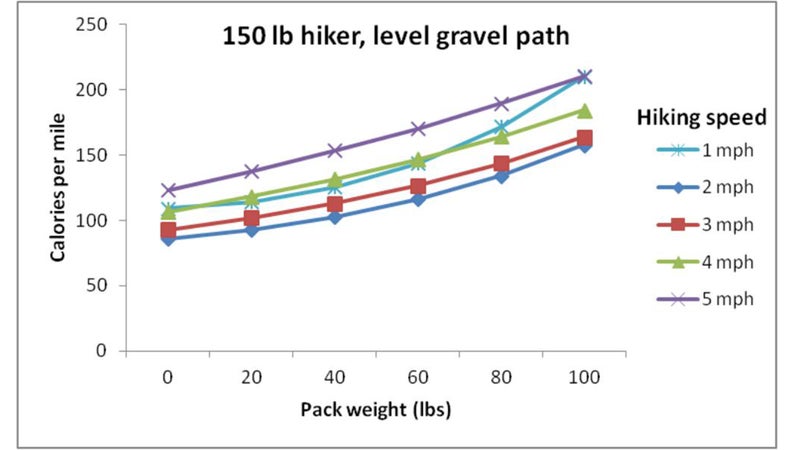
Now things get a little more complex. In this case, the two worst options are the slowest (1 mph) and fastest (5 mph) hiking speeds, with the best options somewhere in the middle. Some of the lines cross each other, so it’s hard to figure out why this is. To get a clearer picture, let’s look at the same data one last time, but this time switch things around so that hiking speed is on the horizontal axis and pack weight is shown with different lines:
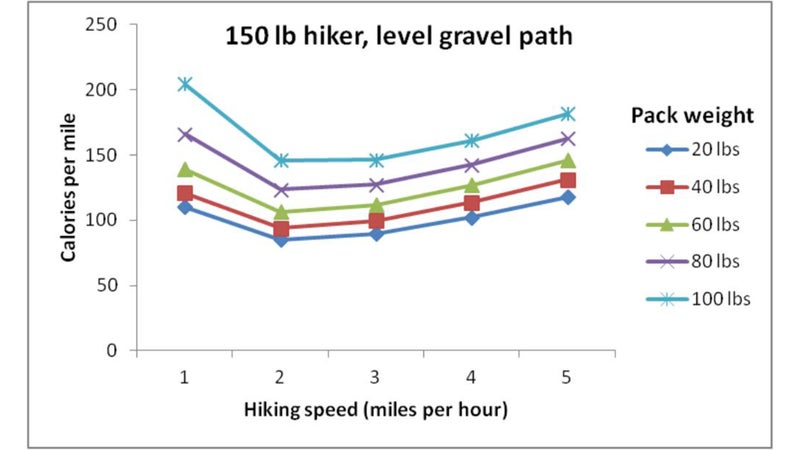
This shows��that walking really slowly is inefficient, particularly if you’re carrying a heavy pack. That makes sense: if you take too long to cover your distance, you’re spending unnecessary time with a big pack weighing you down. So going faster is more efficient—but if you keep speeding up, the cost of trying to walk fast takes over. The sweet spot between walking too fast and supporting the pack for too long, in this sample case, is between 2 and 3 mph. The heavier your pack, the faster the optimal walking speed gets.
It’s important to note that this analysis is only considering the energy cost of walking with a pack. There are other factors that make backpacking hard. For me, at least, keeping a heavy pack on for long periods of time gets uncomfortable no matter how well-fitted it��is. My hips and shoulders start to fatigue and sometimes chafe. So I generally find that I prefer a faster-than-“optimal” speed, which burns some extra calories but minimizes the amount of time I need to keep the pack on. Still, these graphs give you some ideas of how the energetics of backpacking change as you adjust parameters like pack weight and walking speed.
There are other factors we can play around with. For example, how does calorie burn change as a function of slope? Here’s some data for my reference case at slopes from 0 to 15 percent, with walking speeds from 0.5 to 4 mph shown along the horizontal axis:
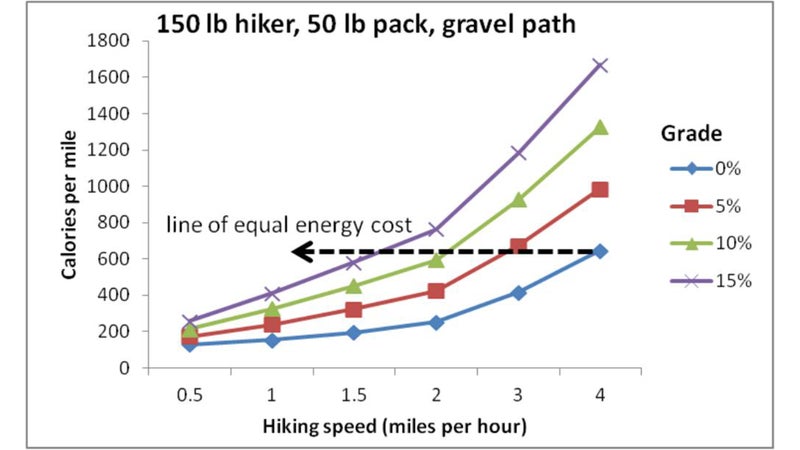
Yes, it takes a lot more energy to walk uphill. But we can extract some more useful information, too. Let’s say you’re used to schlepping along at 4 mph with a 50-pound pack on level ground. Now you’re planning a trip that will involve some prolonged uphill. What speed should you expect to maintain if you plan to expend roughly the same amount of effort (or, more specifically, the same amount of energy)? At a 5-percent grade, you’d have to slow down to 2.9 mph. At a 10-percent grade, it would be 2.2 mph.
The Effect of Terrain
The last detail I’ll pull out is the effect of terrain. All of the above calculations have used a “terrain factor” of 1.2, which is what the Pandolf equation recommends for gravel or dirt roads. But those numbers can change pretty dramatically if you’re on other surfaces. A paved road has a terrain factor of 1.0; swamp has a terrain factor of 3.5. (There’s been lots of research and debate on the appropriate terrain factors over the years; I’m using values from .)
Here’s the calories-per-mile data for various terrains at three different speeds between 2 and 4 mph:
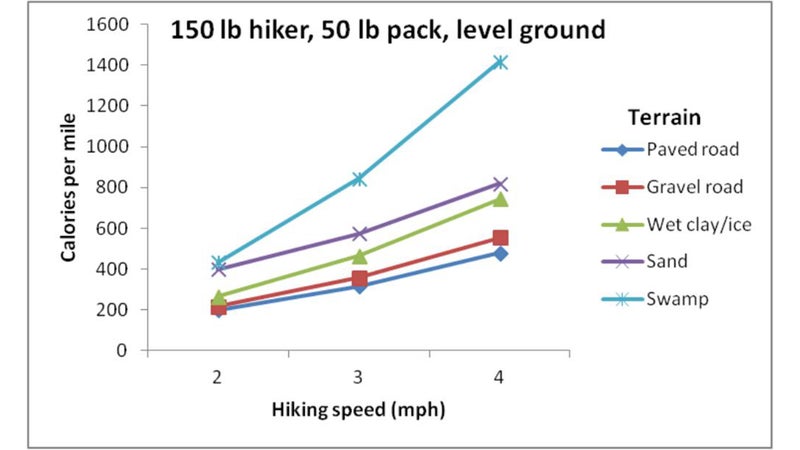
You can see that bad terrain takes a disproportionately big toll at faster speeds. If you’re planning a route through difficult terrain and you don’t factor in a significant slowdown, you’ll be pushing yourself very hard to stay on pace. If you’re clipping along at 4 mph on a gravel path, then come to a section of ice (terrain factor 1.7), you’ll slow down by about 15 percent to 3.4 mph if you maintain the same energy output. Sand��is a little more complicated: its terrain factor��is (1.5 + 1.3/V^2), meaning that it��changes with hiking speed, so that the slower you go, the harder it gets.
So that’s the Pandolf equation. Exactly what it tells you will depend on the specific details of your trip, which is why we’ve designed a simple calculator that allows you to calculate your own caloric cost. Simply plug in your weight and your pack’s weight (in pounds), your hiking speed (in miles per hour), and the grade you’ll be hiking on (in percent), and select one of the terrain options, and the calculator will estimate your caloric cost in calories per hour and calories per mile. Have fun playing with it… and always pack an extra day’s food just in case.
My new book, , with a foreword by Malcolm Gladwell, is now available. For more, join me on and , and sign up for the Sweat Science .


